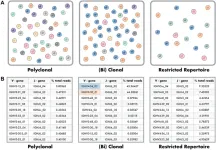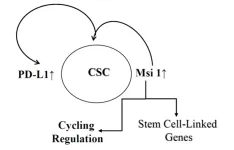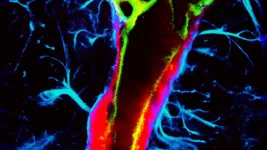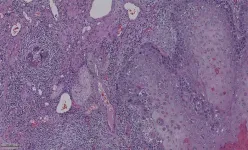(Press-News.org) Researchers at Rutgers University have found a major flaw in the way that algorithms designed to detect "fake news" evaluate the credibility of online news stories.
Most of these algorithms rely on a credibility score for the "source" of the article, rather than assessing the credibility of each individual article, the researchers said.
"It is not the case that all news articles published by sources labeled 'credible' (e.g., The New York Times) are accurate, nor is it the case that every article published by sources labeled 'noncredible' publications are 'fake news,'" said Vivek K. Singh, an associate professor at the Rutgers School of Communication and Information and coauthor of the study “Misinformation Detection Algorithms and Fairness Across Political Ideologies: The Impact of Article Level Labeling” published on OSFHome.
"Our analysis shows that labeling articles for misinformation based on the source is as bad an idea as just flipping a coin and assigning true/false labels to news stories," added Lauren Feldman, an associate professor of journalism and media studies at the School of Communication and Information, who is another coauthor of the paper.
The researchers found using source-level labels for credibility isn’t a reliable method, with article-level labels matching 51% of the time. This labeling process has important implications for tasks such as the creation of robust fake news detectors and for audits on fairness across the political spectrum.
To address this problem, the study offers a new dataset of journalistic quality individually labeled articles and an approach for misinformation detection and fairness audits. The findings of this study highlight the need for more nuanced and reliable methods of detecting misinformation in online news and provide valuable resources for future research in this area.
Researchers assessed the credibility and political leaning of 1,000 news articles and used these article-level labels to build misinformation detection algorithms. Then, they evaluated how the labeling methodology (source level versus article level) impacts the performance of misinformation detection algorithms.
Their aim was to explore the impact of article-level labeling on the process and determine if the bias that exists when applying machine-learning approach at the source level still exists when applying the same machine-learning approach to individual articles, and, in addition, to learn if bias is reduced when dealing with individually labeled articles.
The authors presented their paper at the 15th Association for Computing Machinery Web Science Conference 2023, held from April 30-May 1 in Austin, Texas.
A joint effort between journalism, information science and computer science professionals, the authors, in addition to Singh and Feldman, include Jinkyung Park, a Ph.D. alumna of the School of Communication and Information; Rahul Dev Ellezhuthil, a computer science master’s degree student; School of Communication and Information doctoral student Joseph Isaac; and Christoph Mergerson, a Ph.D. alumnus of the School of Communication and Information and an assistant professor of race and media at the University of Maryland.
The authors said algorithms used to detect misinformation in online articles function the way they do “mainly because there is a dearth of fine-grained labels defined at the news article level. We acknowledge that labeling each news article may not be feasible given the massive volume of news articles that are published and disseminated on the web. At the same time, there are reasons to question the validity of datasets labeled at the source level.”
“Validating online news and preventing the spread of misinformation is critical for ensuring trustworthy online environments and protecting democracy,” the authors wrote, adding that their work “aims to increase public confidence in misinformation detection practices and subsequent corrections by ensuring the validity and fairness of results,” and their dataset and the conceptual results “aim to pave the way for more reliable and fair misinformation detection algorithms.”
Funding for this research was provided by the National Science Foundation.
END
Rutgers researchers find flaws in using source reputation for training automatic misinformation detection algorithms
A Rutgers study shows that article level labeling is important to improve the detection of misinformation and ensuring fairness of the process
2023-05-16
ELSE PRESS RELEASES FROM THIS DATE:
How government guarantees give banking customers peace of mind and keep banks open
2023-05-16
Spooked by volatile reports from the Silicon Valley Bank in early March, many customers panicked and withdrew their money, creating the largest bank failure since the 2007-2008 financial crisis. The problem — investors and customers lost confidence in the bank, proving the perception of a banks’ reliability can significantly impact its success.
Investors tend to respond negatively to volatility in firms’ performance. To mitigate investors’ concerns, when some banks receive extremely high income, they occasionally delay reporting that amount until a later date when the income ...
Automated, accurate reporting for NGS-based clonality testing
2023-05-16
“[...] we have developed a fully automated calling algorithm for determining B and T cell clonality from NGS [next-generation sequencing] data, with greater sensitivity than previously developed models.”
BUFFALO, NY- May 16, 2023 – A new research paper was published in Oncotarget's Volume 14 on May 12, 2023, entitled, “Development and implementation of an automated and highly accurate reporting process for NGS-based clonality testing.”
B and T cells undergo random recombination of the VH/DH/JH portions of the immunoglobulin loci (B cell) and T-cell receptors before becoming ...
Musashi 1 in breast cancer: Implications for dormancy and survival in bone marrow
2023-05-16
“This study now links Msi 1 to PD-L1.”
BUFFALO, NY- May 16, 2023 – A new research paper was published in Aging (listed by MEDLINE/PubMed as "Aging (Albany NY)" and "Aging-US" by Web of Science) Volume 15, Issue 9, entitled, “Increased expression of musashi 1 on breast cancer cells has implication to understand dormancy and survival in bone marrow.”
Breast cancer (BC) stem cells (CSCs) resist treatment and can exist as dormant cells in tissues such as the bone marrow (BM). Years before clinical diagnosis, BC cells (BCCs) could migrate from the primary site where the BM niche ...
UC Irvine research team identifies glycosylation enzyme critical in brain formation
2023-05-16
Irvine, Calif., May 16, 2023 — The MGAT5 glycosylation enzyme plays a crucial role in brain development, according to a study by University of California, Irvine researchers, a discovery that may contribute to new therapeutic purposes for neural stem cells.
Neurons, astrocytes and oligodendrocytes are the final mature cells of the brain and spinal cord formed by neural stem cells. Each has distinct and key functions. Neurons transmit signals, astrocytes help modify those signals, and oligodendrocytes ...
Insight into brain’s waste clearing system may shed light on brain diseases
2023-05-16
Like the lymphatic system in the body, the glymphatic system in the brain clears metabolic waste and distributes nutrients and other important compounds. Impairments in this system may contribute to brain diseases, such as neurodegenerative diseases and stroke.
A team of researchers in the McKelvey School of Engineering at Washington University in St. Louis has found a noninvasive and nonpharmaceutical method to influence glymphatic transport using focused ultrasound, opening the opportunity to use the method to further study brain diseases and brain function. Results of the work are published in the Proceedings ...
Dr. David Simon wins Pershing Square Sohn Prize for Young Investigators in Cancer Research Studying Melanoma
2023-05-16
The prize, now in its 10th year, is given annually to at least six early-career scientists based in the New York City area by The Pershing Square Sohn Cancer Research Alliance. Prizes are awarded to scientists who are pursuing innovative cancer research and taking risks that might preclude them from traditional funding. Winners receive $250,000 a year for up to three years and access to networking opportunities and an annual retreat with past winners.
For Dr. Simon, the prize will allow him to apply his knowledge as a neuroscientist to cancer research. “I'm not a traditional cancer biologist,” said Dr. ...
Saturated fatty acids promote immune escape of oral cancers
2023-05-16
A team from the University of Michigan Rogel Cancer Center and School of Dentistry, led by Yu Leo Lei, D.D.S., Ph.D., have identified a mechanism in mice for how obesity affects some oral cancers’ ability to escape from the immune system.
This study, published in Cell Reports, found that obesity helps to establish a type of tumor microenvironment that promotes tumor progression. How exactly this happens lies in the relationship between the saturated fatty acids, the STING-type-I interferon pathway, and NLRC3.
“We tend to think about the increased risks for gastrointestinal tumors, breast cancer, pancreatic cancer, and ovarian cancer when it comes to obesity,” ...
When does the gender gap start in the computer science field?
2023-05-16
If you are a third grader, your chances of growing up to be a computer scientist is likely to heavily depend on your gender — a situation Allison Master says is just plain wrong.
How can Master be certain? Because third grade girls are telling her so.
“Our new research addresses a big, longstanding issue in STEM education, that women are highly under-represented in fields like computer science. It’s actually one of the most challenging fields for women’s representation. Only about 20% of people who major in computer science are women,” said Master, assistant professor ...
You’ve got some nerve
2023-05-16
Researchers at the University of Michigan Rogel Cancer Center and the School of Dentistry identified a new metric to articulate the relationship between nerve density and oral cancer. The study, published in Clinical Cancer Research, a journal of the American Association for Cancer Research, investigated normalized nerve density to translate previous mechanistic studies into a context that could be used in the clinic.
“We are recognizing more and more that there's a very dynamic interaction between nerves and cancer cells in the tumor microenvironment,” said Nisha D’Silva, B.D.S., M.S.D, Ph.D., Donald Kerr Endowed Collegiate ...
National study recommends starting SARS-CoV-2 mRNA vaccination three months after bone marrow transplant
2023-05-16
SEATTLE – (May 16, 2023) – Patients with cancer whose immune systems are being supported or rebuilt by bone marrow transplantation should begin receiving vaccines for protection against SARS-CoV-2 three months post-transplant, according to a large, prospective, observational study led collaboratively by the Center for International Blood and Marrow Transplant Research, the Blood & Marrow Transplant Clinical Trials Network and Fred Hutchinson Cancer Center. The research, involving 22 cancer centers and research institutions in the United States and focusing on mRNA-based vaccines, published in The Lancet journal ...
LAST 30 PRESS RELEASES:
New design playbook could unlock next generation high energy lithium ion batteries
Drones reveal how feral horse units keep boundaries
New AI tool removes bottleneck in animal movement analysis
Bubble netting knowledge spread by immigrant humpback whales
Discovery of bats remarkable navigation strategy revealed in new study
Urban tributaries identified as major sources of plastic chemical pollution in the Yangtze River
UK glaucoma cases higher than expected and projected to reach 1.6 million+ by 2060
Type 2 diabetes prevention could more than halve carbon footprint linked to disease complications
Over 1 million estimated to have glaucoma in UK
Early treatment can delay rheumatoid arthritis for years
National childhood type 1 diabetes screening is effective and could prevent thousands of emergency diagnoses, UK study shows
Mix of different types of physical activity may be best for longer life
Continuous care from community-based midwives reduces risk of preterm birth by 45%
Otago experts propose fiber as first new essential nutrient in 50 years
Auburn Physics PhD student earns prestigious DOE Fellowship
AI tool helps you learn how autistic communication works
To show LGBTQ+ support, look beyond Pride Month
Using artificial intelligence to understand how emotions are formed
Exposure to wildfire smoke late in pregnancy may raise autism risk in children
Breaking barriers in lymphatic imaging: Rice’s SynthX Center leads up to $18 million effort for ‘unprecedented resolution and safety’
Dhaval Jadav joins the SETI Institute Board to help spearhead novel science and technology approaches in the search for extraterrestrial life
Political writing retains an important and complex role in the national conversation, new book shows
Weill Cornell Medicine receives funding to develop diagnostic toolbox for lymphatic disease
It started with a cat: How 100 years of quantum weirdness powers today’s tech
McGill researchers identify a range of unexpected chemical contaminants in human milk
Physical therapy research highlights arthritis’ toll on the workforce — and the path forward
Biomedical and life science articles by female researchers spend longer under review
Forgetting in infants can be prevented in mice by blocking their brain’s immune cells
Blocking immune cells in the brain can prevent infant forgetting
AI-driven ultrafast spectrometer-on-a-chip: A revolution in real-time sensing
[Press-News.org] Rutgers researchers find flaws in using source reputation for training automatic misinformation detection algorithmsA Rutgers study shows that article level labeling is important to improve the detection of misinformation and ensuring fairness of the process





